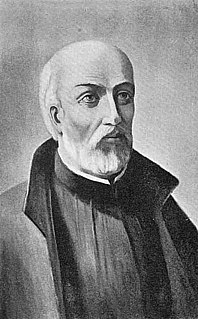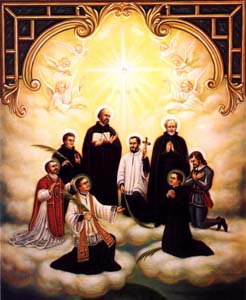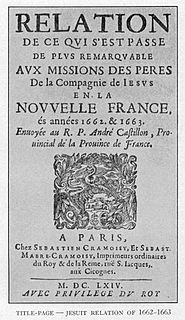
The Society of Jesus, also known as the Jesuits, is a religious order of the Catholic Church headquartered in Rome. It was founded by Ignatius of Loyola and six companions with the approval of Pope Paul III in 1540. The society is engaged in evangelization and apostolic ministry in 112 nations. Jesuits work in education, research, and cultural pursuits. Jesuits also give retreats, minister in hospitals and parishes, sponsor direct social ministries, and promote ecumenical dialogue.

The Bollandist Society are an association of scholars, philologists, and historians who since the early seventeenth century have studied hagiography and the cult of the saints in Christianity. Their most important publication has been the Acta Sanctorum. They are named after the Flemish Jesuit Jean Bollandus (1596–1665).

Jean de Brébeuf was a French Jesuit missionary who travelled to New France (Canada) in 1625. There he worked primarily with the Huron for the rest of his life, except for a few years in France from 1629 to 1633. He learned their language and culture, writing extensively about each to aid other missionaries.

The Canadian Martyrs, also known as the North American Martyrs, were eight Jesuit missionaries from Sainte-Marie among the Hurons. They were ritually tortured and killed on various dates in the mid-17th century in Canada, in what is now southern Ontario, and in upstate New York, during the warfare between the Iroquois and the Huron. They have subsequently been canonized and venerated as martyrs by the Catholic Church.

Kateri Tekakwitha, given the name Tekakwitha, baptized as Catherine and informally known as Lily of the Mohawks, is a Catholic saint and virgin who was an Algonquin–Mohawk. Born in the Mohawk village of Ossernenon, on the south side of the Mohawk River in present-day New York State, she contracted smallpox in an epidemic; her family died and her face was scarred. She converted to Catholicism at age nineteen, when she was baptized and given the Christian name Kateri in honor of Catherine of Siena. Refusing to marry, she left her village and moved for the remaining five years of her life to the Jesuit mission village of Kahnawake, south of Montreal on the St. Lawrence River in New France, now Canada.
Isaac Jogues, S.J. was a French missionary and martyr who traveled and worked among the Iroquois, Huron, and other Native populations in North America. He was the first European to name Lake George, calling it Lac du Saint Sacrement. In 1646, Jogues was martyred by the Mohawk at their village of Ossernenon, near the Mohawk River.

The Society of Priests of Saint-Sulpice is a society of apostolic life of Pontifical Right, named after the Church of Saint-Sulpice, Paris, where it was founded. The members of the Society add the nominal letters PSS after their names to indicate membership in the Congregation. Typically, priests become members of the Society of the Priests of St. Sulpice only after ordination and some years of pastoral work. The purpose of the society is mainly the education of priests and to some extent parish work. As their main role is the education of those preparing to become priests, Sulpicians place great emphasis on the academic and spiritual formation of their own members, who commit themselves to undergoing lifelong development in these areas. The Society is divided into three provinces, operating in various countries: the Province of France, Canada, and the United States.
The Seven Nations of Canada was a historic confederation of First Nations living in and around the Saint Lawrence River valley beginning in the eighteenth century. They were allied to New France and often included substantial numbers of Roman Catholic converts. During the Seven Years' War (1756–1763), they supported the French against the British. Later, they formed the northern nucleus of the British-led Aboriginal alliance that fought the United States in the American Revolutionary War and the War of 1812.

René Goupil, S.J., was a French Jesuit lay missionary who became a lay brother of the Society of Jesus shortly before his death. He was the first of the eight North American Martyrs of the Roman Catholic Church to receive the crown of martyrdom and the first canonized Catholic martyr in North America.

Antoine Daniel was a French Jesuit missionary in North America, at Sainte-Marie among the Hurons, and one of the eight Canadian Martyrs.

Jean de Lalande was a Jesuit missionary at Sainte-Marie among the Hurons and one of the eight North American Martyrs. He was killed at the Mohawk village of Ossernenon after being captured by warriors.

Gabriel Lalemant was a French Jesuit missionary in New France beginning in 1646. Caught up in warfare between the Huron and nations of the Iroquois Confederacy, he was killed in St. Ignace by Mohawk warriors and is one of the eight Canadian Martyrs.

Auriesville is a hamlet in the northeastern part of the Town of Glen in Montgomery County, New York, United States, along the south bank of the Mohawk River and west of Fort Hunter. It lies about forty miles west of Albany, the state capital. A Jesuit cemetery is located there, as French Jesuits founded a mission village at Ossernenon from 1667 until 1684, when the Mohawk destroyed it. Auries is said to have been the name of the last Mohawk known to have lived there. Settlers named the village after him.
The Recollects were a French reform branch of the Friars Minor, a Franciscan order. Denoted by their gray habits and pointed hoods, the Recollects took vows of poverty and devoted their lives to prayer, penance, and spiritual reflection. Today, they are best known for their presence as missionaries in various parts of the world, most notably in early Canada.

The Jesuit Relations, also known as Relations des Jésuites de la Nouvelle-France, are chronicles of the Jesuit missions in New France. The works were written annually and printed beginning in 1632 and ending in 1673.

Paul Le Jeune (1591–1664) was a French Jesuit missionary in New France. He served as the Superior of the Jesuits in Canada from 1632 to 1639. During his tenure, he began a mission at Trois-Rivières, founded the community at Sillery, and saw the establishment of the Hôtel-Dieu de Québec.

Jesuit missions in North America were attempted in the late 16th century, established early in the 17th century, faltered at the beginning of the 18th, disappeared during the suppression of the Society of Jesus around 1763, and returned around 1830 after the restoration of the Society. The missions were established as part of the colonial drive of France and Spain during the period, the "saving of souls" being an accompaniment of the constitution of Nouvelle-France and early New Spain. The efforts of the Jesuits in North America were paralleled by their China missions on the other side of the world, and in South America. They left written documentation of their efforts, in the form of The Jesuit Relations.

Ignatius of Loyola, S.J., venerated as Saint Ignatius of Loyola, was a Spanish Catholic priest and theologian, who, with Peter Faber and Francis Xavier, founded the religious order of the Society of Jesus, and became the first Superior General of the Society of Jesus, in Paris, in 1541. He envisioned the purpose of the Society of Jesus to be missionary work and teaching. Unlike members of other religious orders in the church, who take the vows of chastity, obedience and poverty, members of the Jesuit society also take a fourth vow of obedience to the Pope, to engage in projects ordained by the pontiff. Jesuits were instrumental in leading the Counter-Reformation.

Meductic Indian Village / Fort Meductic was a Maliseet settlement until the mid-eighteenth century. It was located near the confluence of the Eel River and Saint John River in New Brunswick, four miles upriver from present-day Meductic, New Brunswick. The fortified village of Meductic was the principal settlement of the Maliseet First Nation from before the 17th century until the middle of the 18th, and it was an important fur trading centre..













